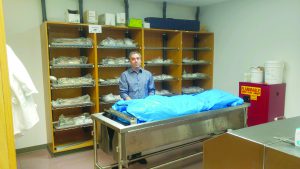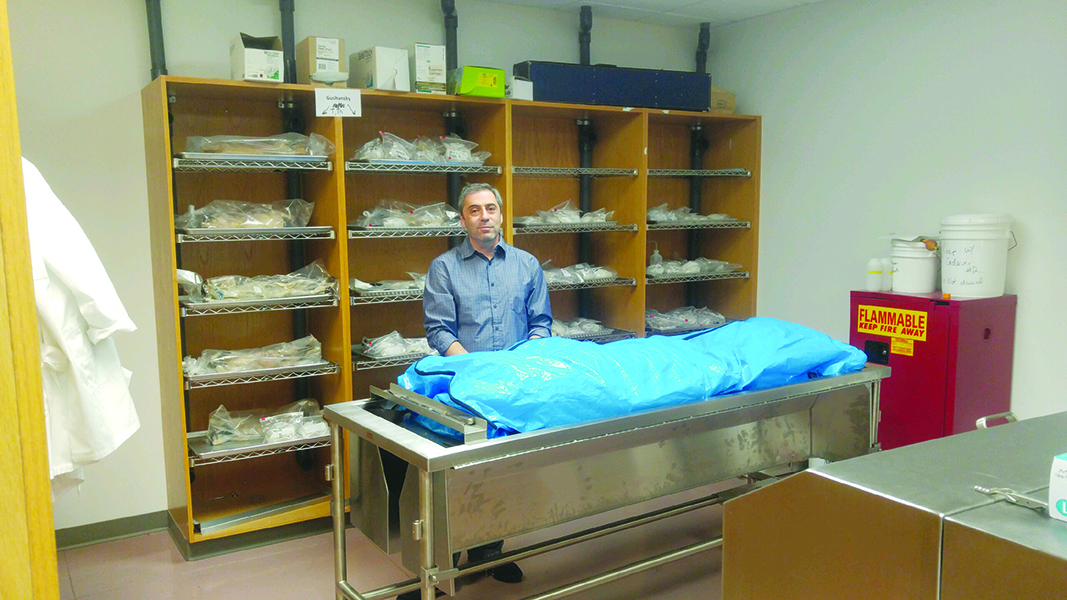 Students are dissecting and investigating the remnants of human cadavers on campus.
Students are dissecting and investigating the remnants of human cadavers on campus.
Palomar has three cadavers on campus for students who are looking to specialize in the field of anatomy. The correlating major for this specialization would be pre-nursing, occupational therapy, kinesiology, and physical therapy.
Each cadaver is leased for a period of up to seven years from University of California San Diego Medical Center for around $3,000, according to Anatomy Professor Gene Gushansky. These bodies are donated to science, where UCSD receives and embalms bodies for dissection of medical students. The cost of each cadaver includes the preparation and delivery to and from Palomar.
Gushansky headed and started the cadaver lab where the program has been accessible to Palomar students since 2010. Gushansky is a full-time faculty member, has been employed to Palomar College since 2009, and is the Anatomy Advisor for directed studies.
“For 27 years, Palomar did not have a cadaver program. When I came, I restarted the program and arranged for funding of our first cadaver,” Gushansky said. “From then, we had students volunteer to prepare the bodies, and we have been growing ever since.”
In respect for the cadavers, students take extreme care and caution while dissecting, and ensure cadaver faces are covered throughout the entire process. Also, every scrap of tissue collected from the body is returned with the proper cadaver when it returned to UCSD for cremation. This type of work is not for the faint-hearted, and cat dissections are made available to students who do not feel as comfortable working with a human body.
Associated Student Government President Malik Spence said, “It’s a great experience getting hands on experience as to what the human body actually looks like on the inside. You really find out how complex and fragile the human body is.”
Pre-medical majors have two options available that offer practice with cadavers: ZOO 200 and ZOO 295 (soon to both have BIO prefixes). Within the directed studies course, ZOO 295, enrollment typically ranges between 10-15 students a semester. However, per Fall 2016 enrollment, there are five students enrolled.
“It is essential if you are going into any pre-med field, and you really get the entire feel when working on a cadaver,” Spence said.
Many former students, also referred to as “minions” by Gushansky, visit and assist classes that deal with cadavers by preparing bodies and answering questions students may have if the professor is unavailable.
Chris Velis, a Palomar alumnus and current California State University, San Marcos student has been volunteering in Palomar’s anatomy labs and said that anatomy was meaningful to him so much so that he plans on becoming a teacher.“Working with a cadaver is very beneficial for the hands-on experience and is one of the fastest ways to learn,” Velis said. “Anatomy is actually seeing what the human looks like and functions, and provides a lot more insight than a model.”
In the future, Professor Gushansky is looking to expand the program as there is a growing need for anatomy courses at Palomar. Currently, there are two full-time instructors and three adjunct professors who supervise and assist students with cadavers. Professor Gushansky hopes to hire a larger full-time staff base and start a new program where Palomar will lease a new cadaver per year for students to work on.
If you are interested and would like further information regarding pre-medical majors that work with cadavers and anatomy, please visit the Life Sciences Department online at palomar.edu/pages/lifescience/ or the Academic Department Assistant, Karen Buehler, at (760) 744-1150 ext, 2275 to be directed to the proper contact.
Image Sources
- cadaver-cmyk: Steven Rivera/The Telescope | All Rights Reserved

